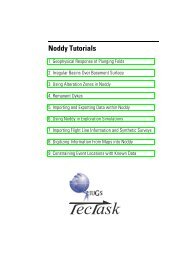Revised Eburnean geodynamic evolution of the ... - Tectonique.net
Revised Eburnean geodynamic evolution of the ... - Tectonique.net
Revised Eburnean geodynamic evolution of the ... - Tectonique.net
You also want an ePaper? Increase the reach of your titles
YUMPU automatically turns print PDFs into web optimized ePapers that Google loves.
28 S. Perrouty et al. / Precambrian Research 204– 205 (2012) 12– 39<br />
Fig. 10. Stereo-plot diagrams representing measurement distribution on equal area diagram (lower hemisphere), with density contours, for <strong>the</strong> three main rocks groups. (A)<br />
Distribution <strong>of</strong> <strong>the</strong> Kumasi Group and Tarkwaian sediments bedding poles are in good agreement with <strong>the</strong> F3 folding (and S3 cleavage orientations). In contrast <strong>the</strong> Sefwi<br />
Group bedding poles plots shows a wider dispersion resulting from <strong>the</strong> interference <strong>of</strong> multiple fold generations (mostly F1 and F3). Stereo-plots <strong>of</strong> poles to S1 confirm<br />
<strong>the</strong> presence <strong>of</strong> <strong>the</strong> earlier event (D1) affecting only <strong>the</strong> Sefwi Group. (B) D4 data are predominantly from <strong>the</strong> Wassa mine (Sefwi Group), although <strong>the</strong> S4 cleavage is<br />
also observed in <strong>the</strong> Kumasi Group and in <strong>the</strong> Tarkwa Group along <strong>the</strong> Ashanti Fault. S5 is sub-horizontal and consistent across each group. S6 corresponds to subvertical<br />
crenulation cleavage striking NW-SE.<br />
observations made in <strong>the</strong> field (Tarkwaian bedding, S3 cleavage)<br />
and features imaged in <strong>the</strong> radiometric/radar data (e.g. F3 regional<br />
folds imaged in <strong>the</strong> combined radiometric/radar image do not<br />
appear in <strong>the</strong> mag<strong>net</strong>ic data, Fig. 14).<br />
Previous studies (Table 2) have estimated <strong>the</strong> total thickness<br />
<strong>of</strong> Tarkwaian sedimentary layers from 1000 to 3000 m. Assuming a<br />
maximum 3000 m depth for <strong>the</strong> Tarkwa Basin, several tests (Fig. 15)<br />
with various susceptibility contrasts were conducted using Noddy<br />
s<strong>of</strong>tware (Jessell, 1981, 2001; Jessell and Valenta, 1996). The models<br />
suggest that in order to image structure in <strong>the</strong> buried Birimian basement,<br />
<strong>the</strong> Birimian must contain lithologies with approximately<br />
5 times greater susceptibility than <strong>the</strong> overlying Tarkwa Group.<br />
Measurements <strong>of</strong> mag<strong>net</strong>ic susceptibility within <strong>the</strong> Tarkwaian<br />
sediments show values that are indeed significantly lower (10 times<br />
or more) than <strong>the</strong> underlying Sefwi Group metavolcanics, with <strong>the</strong><br />
exception <strong>of</strong> <strong>the</strong> few conglomerate layers. It is <strong>the</strong>refore possible<br />
that <strong>the</strong> mag<strong>net</strong>ic data are not imaging structures within <strong>the</strong><br />
Tarkwa Group but ra<strong>the</strong>r <strong>the</strong> structures in <strong>the</strong> underlying relatively<br />
mag<strong>net</strong>ic Sefwi Group metasediments and metavolcanics.<br />
With this in mind we can interpret trends in <strong>the</strong> mag<strong>net</strong>ic images as<br />
D1 structures in <strong>the</strong> Sefwi Group that formed prior to <strong>the</strong> deposition<br />
<strong>of</strong> <strong>the</strong> Tarkwaian sediments.




